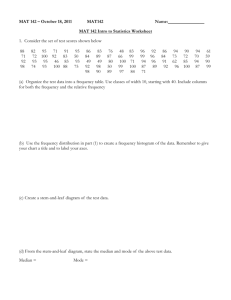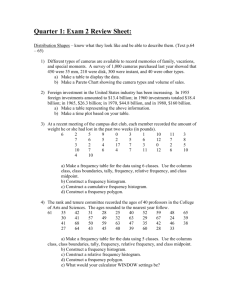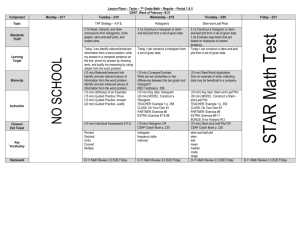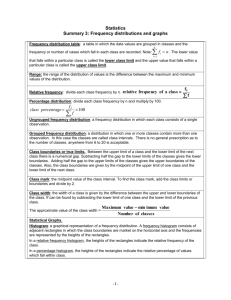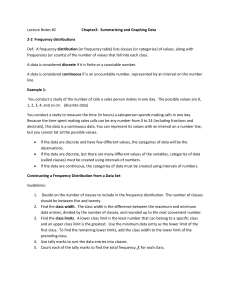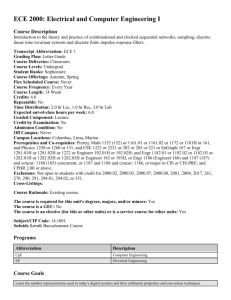Stem-and-Leaf Displays:
advertisement
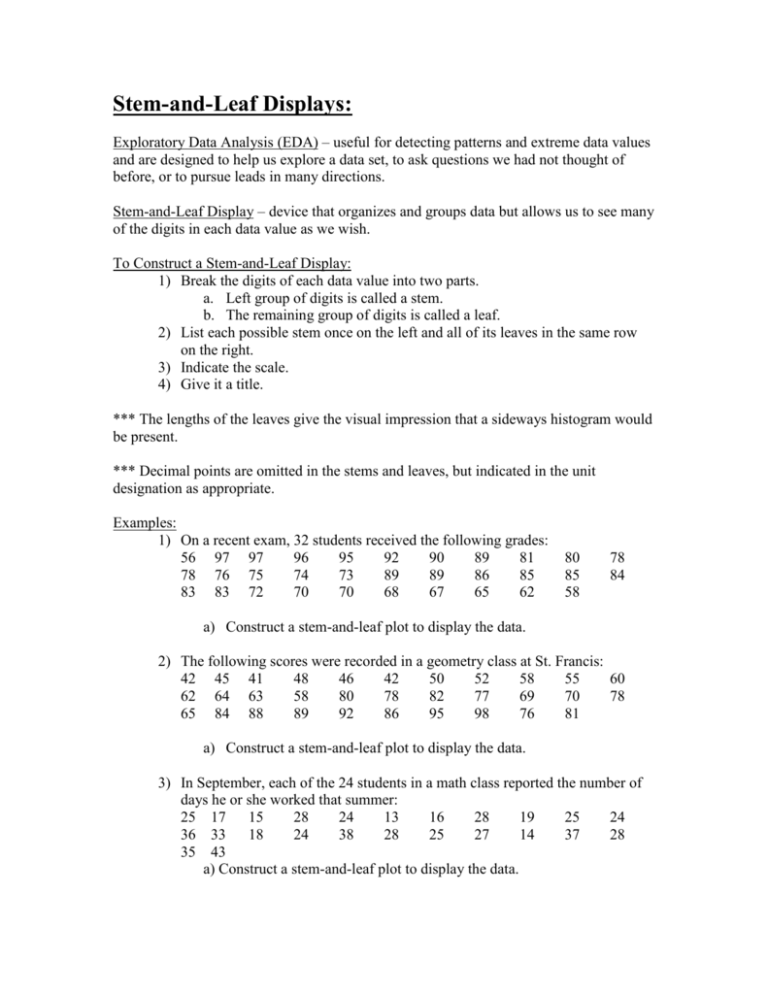
Stem-and-Leaf Displays: Exploratory Data Analysis (EDA) – useful for detecting patterns and extreme data values and are designed to help us explore a data set, to ask questions we had not thought of before, or to pursue leads in many directions. Stem-and-Leaf Display – device that organizes and groups data but allows us to see many of the digits in each data value as we wish. To Construct a Stem-and-Leaf Display: 1) Break the digits of each data value into two parts. a. Left group of digits is called a stem. b. The remaining group of digits is called a leaf. 2) List each possible stem once on the left and all of its leaves in the same row on the right. 3) Indicate the scale. 4) Give it a title. *** The lengths of the leaves give the visual impression that a sideways histogram would be present. *** Decimal points are omitted in the stems and leaves, but indicated in the unit designation as appropriate. Examples: 1) On a recent exam, 32 students received the following grades: 56 97 97 96 95 92 90 89 81 78 76 75 74 73 89 89 86 85 83 83 72 70 70 68 67 65 62 80 85 58 78 84 a) Construct a stem-and-leaf plot to display the data. 2) The following scores were recorded in a geometry class at St. Francis: 42 45 41 48 46 42 50 52 58 55 60 62 64 63 58 80 78 82 77 69 70 78 65 84 88 89 92 86 95 98 76 81 a) Construct a stem-and-leaf plot to display the data. 3) In September, each of the 24 students in a math class reported the number of days he or she worked that summer: 25 17 15 28 24 13 16 28 19 25 24 36 33 18 24 38 28 25 27 14 37 28 35 43 a) Construct a stem-and-leaf plot to display the data. 4) The following data represents the times that 22 athletes at St. Francis took to complete an obstacle course: 9.8 9.7 8.6 4.5 4.6 8.5 9.9 9.3 9.1 9.0 5.4 5.5 8.2 7.9 7.8 9.5 5.3 6.6 6.6 8.7 7.8 8.0 a) Construct a stem-and-leaf plot to display the data. Multiple Lines Per Stem: We could also construct a stem-and-leaf display which spreads the data out even more. We call this multiple lines per stem. In this case we can say that leaves 0 - 4 would go with one stem and leaves 5 - 9 would go with a second stem. However, if you would like to use a multiple line stem-and-leaf, you must use an asterisk (*) for your first stem and a raised dot (•) for your second stem. (See page 81.) Examples: 1) The following grades were scored on a recent exam: 100 93 71 74 85 56 62 68 99 85 77 85 48 51 79 25 88 70 100 26 67 70 86 100 93 a) Construct a stem-and-leaf plot with two lines per stem. 2) Over the last 35 games, L. James scored the following amount of points: 16 22 54 18 22 39 16 22 44 23 28 27 50 26 24 26 19 11 9 18 34 51 50 39 31 30 27 28 19 19 23 34 31 45 42 a) Construct a stem-and-leaf plot with two lines per stem. 3) The following number of slices were sold each month at Fresh Meadows (over the last 2 years): 308 309 319 298 297 294 316 328 329 334 308 300 311 319 326 324 333 337 308 305 291 290 333 319 a) Construct a stem-and-leaf plot with two lines per stem. Back –to-Back Stem Plot: Many real-life applications of statistics involve comparisons of two populations. Examples: 4) The caloric intake of 20 people on each of two weight loss programs are recorded as follows: Program A: 1184 1180 1186 1183 1189 1182 1188 1187 1188 1188 1188 1188 1187 1184 1184 1184 1184 1187 1182 1186 Program B: 1187 1187 1183 1182 1187 1180 1182 1182 1185 1181 1187 1187 1189 1184 1184 1187 1187 1186 1184 1184 a) Construct a back-to-back stem-and-leaf plot to display the data. 5) In a 40 year study, survival years were measured for cancer patients undergoing one of two different chemotherapy treatments. The data for 25 patients on the first drug and 30 on the second were as follows: Drug A: 5 21 13 10 3 28 17 12 11 39 11 14 29 19 21 25 10 20 4 4 22 8 17 31 18 Drug B: 19 18 18 12 28 20 20 29 22 28 20 35 22 15 30 35 32 18 1 31 25 21 24 24 21 22 19 26 26 21 a) Construct a back-to-back stem-and-leaf plot to display the data. 6) Is it easier for the best National Basketball Association (NBA) players to get a rebound or an assist? During the 1994-1995 season the top 20 rebounding leaders averaged the following numbers of rebounds per game: 16.8 (Rodman), 12.6, 11.4, 11.1, 11.0, 10.9, 10.9, 10.8, 10.8, 10.6, 10.6, 10.4, 10.3, 9.9, 9.7, 9.7, 9.6, and 9.4. The top 20 assist leaders averaged the following numbers of assists per game: 12.3 (Stockton), 9.4, 9.3, 8.8, 8.7, 8.3, 8.2, 7.9, 7.7, 7.7, 7.6, 7.5, 7.3, 7.2, 7.1, 6.9, 6.4, 6.2, 6.1, and 5.7. Compare these data using back-to-back stemplots. Comment on shape and outliers.
